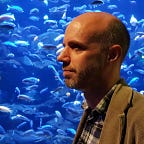‘La Vampire Nue’ or — Better Than Kubrick?
‘La Vampire Nue’ (1970) is Jean Rollin’s second feature film and his first in colour and two things are immediately apparent: the first is Rollin’s enthusiastic and confident use of colour; the second is a stronger grip on narrative. The result is one of his most seriously engaging and satisfying movies.
A man, Pierre, encounters a beautiful woman dressed only in an orange negligee (Leighton’s ‘Flaming June’ come to “life”?) on the suburban streets of Paris late one night as she’s stalked by three mysteriously masked men. Pierre discreetly trails them as they capture and escort the woman into the gated grounds of a large mansion… a mansion owned by Pierre’s father! They are then followed by a group of richly attired guests arriving for what appears to be an exclusive, high-end party.
Confronting his father about the incident Pierre is told that the girl has a rare blood condition that allows her to heal immediately and that this might hold the key to immortality. Suspecting his father is keeping the truth from him, and determined to discover more, Pierre insinuates himself into a group of guests for the next party where it is revealed that the beautiful woman is actually a vampire and the guests are her worshippers.
Although is she really a vampire? Maybe there’s even more to discover!
What instantly whacks you round the face is the boldness of colour, lighting and imagery Rollin smacks us with. The three strange figures at the beginning are obviously masked humans but the astonishing dreamlike atmosphere Rollin creates leaves us wondering if they’re possibly demonic creatures, corrupted entities or even if they exist at all. It’s an excellent example of Rollin taking a straight forward plot and stripping it down to its basic elements in order to then present it via a series of arresting and stimulating images; it’s Surrealism meets the visual storytelling of silent cinema and the effect is completely hypnotising.
This dreamlike space in a 1970’s French mansion with vampire vibes gives the film the feeling of, say, Jacques Rivette directs ‘Blade’ (1998) but there’s also a strong sci-fi element at play, something first hinted at by the vials of multi-coloured liquids bubbling in a lab. This only grows until, by the end, the horror and sci-fi(ish) elements combine in a way that predates Don Coscarelli’s ‘Phantasm’ (1979) and it’s just as trippy.
Although the film’s strongest similarity is with Kubrick’s ‘Eyes Wide Shut’ (1999) where a man entranced with a beautiful woman infiltrates an expensive mansion to observe a masked Satanic/occult/sex party. The main difference is Rollin handles the mystery, eroticism and lighting better than Kubrick did with all his suffocating perfectionism and millions of bloody Christmas tree lights (overcompensating for something here are we, Stanley?). A great example of this is when Pierre walks out into the grounds at night while a steadily growing number of torches follows him revealing just how numerous the “vampire army” really is, and unlike Kubrick’s imaginatively and sensuously inert dollop of unbearable tedium Rollin’s film is bristling with energy, invention and, most importantly, life.
Rollin’s ability to provide just enough imagery on a small budget to get our synapses firing like an unhinged firework display means we start filling in the gaps ourselves and the result is active participation in what we’re seeing (it’s almost as though the viewer is creating the movie whilst watching it) and that’s an extraordinarily exhilarating, stimulating and invigorating experience. What a blast!
